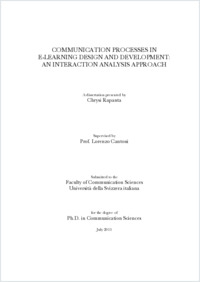Communication processes in eLearning design and development : an interaction analysis approach
- Rapanta, Chrysi
- Cantoni, Lorenzo (Degree supervisor)
-
26.09.2011
325 p.
Thèse de doctorat: Università della Svizzera italiana, 2011 (jury note: Magna cum laude)
Team communication
team design
eLearning
qualitative methodological approach
interaction analysis
coding
English
The present dissertation has as a main goal to identify and describe relevant design and communication processes taking place during co-design meetings, in a way suitable to inform practice in similar settings in the field of eLearning design and development. The need for such a research emerges from the inadequacy of prescriptive models that can guide professionals in their communication during the design of on-line courses. This inadequacy has been evident also in other design fields, thus a tendency towards empirical team design research has been recently established. In the margins of this research tendency, several different methods of analyzing how a team actually interacts during design have been hitherto proposed. Our research applies an Interaction analysis approach, akin to take into consideration various aspects of both the design and communication processes taking place in parallel during a professional co-design meeting. Such an approach allows for the study of the team’s double focus during task-oriented interaction: the realization of the task on which interaction focuses on, and the task of communicating about it. Thus, on the basis of viewing team design activity mainly as a socio-cognitive interaction activity, a method of corpus construction and analysis is proposed, namely DROMEAS. DROMEAS takes its name from the coding dimensions to which it refers, namely: Design activity, Representational act, Object, Meta-epistemic reference, Dialogue act, and dialogue sequence. The selection of these dimensions over others is based on the theoretical constructs this dissertation addresses, which are: design co-construction, dialogicality, deliberativeness, intermediary representations, design-related arguments, and user experience. Applying DROMEAS to an extended dataset (7625 interaction units) derived from 15 co-design meetings of two teams – as representative of high reputation European Distance Universities – has led to several insights and observations regarding both the team design practice in the field of eLearning, and the adequacy of DROMEAS as a method to gain such insights. As far as the former is concerned, our results refer to the structure of design and communication processes, in terms of activities, acts, and objects involved, the content “put on the table”, the arguments produced, and the task-related emerging roles. Regarding the latter, methodological considerations such as the adequacy of dialogue acts, instead of speech acts, to describe interaction, the argumentation schemes emerged, and the merging of semantic-cognitive and dialogical aspects regarding communication acts are discussed. As a conclusion, it is found that the design and the communication processes are mutually dependent, and both depend of the team goal appearing as predominant at each instance of interaction. The selection of an Interaction analysis approach has been proven adequate to richly describe team interaction at various levels and through different focuses. Finally, the identification of argumentation schemes in a naturally emerging dataset has been possible, and also the relation between arguments and design-relevant representations – such as proposals, constraints, and requirements.
- Language
-
- English
- Classification
- Education, teaching
- License
-
License undefined
- Identifiers
-
- RERO DOC 25001
- URN urn:nbn:ch:rero-006-110245
- ARK ark:/12658/srd1318334
- Persistent URL
- https://n2t.net/ark:/12658/srd1318334
Statistics
Document views: 609
File downloads:
- Texte intégral: 204
